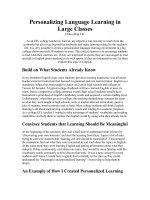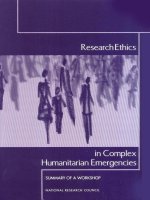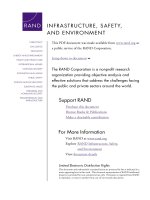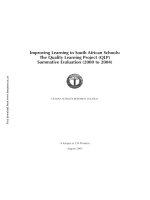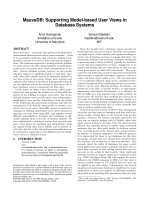Scalable model based reinforcement learning in complex, heterogeneous environments
Bạn đang xem bản rút gọn của tài liệu. Xem và tải ngay bản đầy đủ của tài liệu tại đây (7.88 MB, 129 trang )
SCALABLE MODEL-BASED
REINFORCEMENT LEARNING
IN COMPLEX, HETEROGENEOUS ENVIRONMENTS
NGUYEN THANH TRUNG
B.Sci. in Information Technology
Ho Chi Minh City University of Science
A THESIS SUBMITTED
FOR THE DEGREE OF DOCTOR OF PHILOSOPHY
SCHOOL OF COMPUTING
NATIONAL UNIVERSITY OF SINGAPORE
2013
Acknowledgements
I would like to thank:
Professor Leong Tze Yun, my thesis supervisor, for her guidance, encouragement,
and support throughout my PhD study. I would not have made it through without her
patience and belief in me.
Dr. Tomi Silander, my collaborator and mentor, for teaching me about effective
presentation of technical ideas, and for the numerous hours of invaluable discussions.
He has been a great teacher and a best friend.
Professor David Hsu and Professor Lee Wee Sun for reading my thesis proposal and
providing constructive feedback to refine my work. Professor David Hsu together with
Professor Leong Tze Yun have also offered me a research assistantship to work and
learn in one of their ambitious collaborative projects.
Professor Tan Chew Lim and Professor Wynne Hsu for reading my graduate research
proposal and for suggesting me helpful papers supporting my early research.
Mr. Philip Tan Boon Yew at MIT Game Lab and Mrs. Teo Chor Guan at Singapore-
MIT GAMBIT Game Lab for providing me a wonderful opportunity to experience
MIT culture.
Dr. Yang Haiqin at the Chinese University of Hong Kong for his valuable discussion
and comments on Group Lasso, an important technical concept used in my work.
Members of the Medical Computing Research Group at the School of Computing, for
their friendship and for their efforts in introducing interesting research ideas to the
group in which I am a part.
i
All my friends who have helped and brightend my life over the years at NUS, espe-
cially Chu Duc Hiep, Dinh Thien Anh, Le Thuy Ngoc, Leong Wai Kay, Li Zhuoru,
Phung Minh Tan, Tran Quoc Trung, Vo Hoang Tam, Vu Viet Cuong.
My grandmother, my parents for their unbounded love and encouragement. My brother
and sister for their constant support. My uncle’s family, Nguyen Xuan Tu, for taking
care of me many years in my undergraduate study.
My girl friend, Vu Nguyen Nhan Ai, for sharing the joy and the sorrow with me, for
her patience and belief in me, and most importantly for her endless love.
This research was supported by a Research Scholarship, and two Academic Research
Grants: MOE2010-T2-2-071 and T1 251RES1005 from the Ministry of Education in
Singapore.
ii
Table of Contents
Acknowledgement i
Table of contents iii
Summary vii
Publications from the dissertation research work ix
List of tables xi
List of figures xiii
1 Introduction 1
1.1 Motivations . . . . . . . . . . . . . . . . . . . . . . . . . . . . . . . 2
1.2 Research problems . . . . . . . . . . . . . . . . . . . . . . . . . . . 4
1.2.1 Representation learning in complex environments . . . . . . . 4
1.2.2 Representation transferring in heterogeneous environments . . 4
1.3 Research objectives and approaches . . . . . . . . . . . . . . . . . . 5
1.3.1 Online feature selection . . . . . . . . . . . . . . . . . . . . 6
1.3.2 Transfer learning in heterogeneous environments . . . . . . . 6
1.3.3 Empirical evaluations in a real robotic domain . . . . . . . . 6
1.4 Contributions . . . . . . . . . . . . . . . . . . . . . . . . . . . . . . 7
1.5 Report overview . . . . . . . . . . . . . . . . . . . . . . . . . . . . . 8
2 Background 9
2.1 Reinforcement learning . . . . . . . . . . . . . . . . . . . . . . . . . 9
2.1.1 Markov decision process . . . . . . . . . . . . . . . . . . . . 10
2.1.2 Value function and optimal policies . . . . . . . . . . . . . . 11
2.1.3 Model-based reinforcement learning . . . . . . . . . . . . . . 13
2.2 Model representation . . . . . . . . . . . . . . . . . . . . . . . . . . 16
2.2.1 Tabular transition function . . . . . . . . . . . . . . . . . . . 16
2.2.2 Transition function as a dynamic Bayesian network . . . . . . 17
iii
2.3 Transfer learning . . . . . . . . . . . . . . . . . . . . . . . . . . . . 21
2.3.1 Measurement of a good transfer learning method . . . . . . . 22
2.3.2 Review of existing transfer learning methods . . . . . . . . . 24
2.4 Summary . . . . . . . . . . . . . . . . . . . . . . . . . . . . . . . . 27
3 An overview of the proposed framework 29
3.1 The proposed learning framework . . . . . . . . . . . . . . . . . . . 30
3.2 Summary . . . . . . . . . . . . . . . . . . . . . . . . . . . . . . . . 32
4 Situation calculus Markov decision process 33
4.1 Situation calculus MDP: CMDP . . . . . . . . . . . . . . . . . . . . 34
4.2 mDAGL: multinomial logistic regression with group lasso . . . . . . 37
4.2.1 Multinomial logistic regression . . . . . . . . . . . . . . . . 37
4.2.2 Online learning for regularized multinomial logistic regression 38
4.3 An example . . . . . . . . . . . . . . . . . . . . . . . . . . . . . . . 41
4.4 Summary . . . . . . . . . . . . . . . . . . . . . . . . . . . . . . . . 44
5 Model-based RL with online feature selection 45
5.1 loreRL: the model-based RL with multinomial logistic regression . . . 45
5.2 Experiments . . . . . . . . . . . . . . . . . . . . . . . . . . . . . . . 48
5.2.1 Experiment set-up . . . . . . . . . . . . . . . . . . . . . . . 49
5.2.2 Generalization and convergence . . . . . . . . . . . . . . . . 50
5.2.3 Feature selection . . . . . . . . . . . . . . . . . . . . . . . . 52
5.3 Discussion . . . . . . . . . . . . . . . . . . . . . . . . . . . . . . . . 53
5.4 Summary . . . . . . . . . . . . . . . . . . . . . . . . . . . . . . . . 53
6 Transferring expectations in model-based RL 55
6.1 TES: transferring expectations . . . . . . . . . . . . . . . . . . . . 57
6.1.1 Decomposition of transition model . . . . . . . . . . . . . . . 57
6.1.2 A multi-view transfer framework . . . . . . . . . . . . . . . . 58
6.2 View learning . . . . . . . . . . . . . . . . . . . . . . . . . . . . . . 61
6.3 Experiments . . . . . . . . . . . . . . . . . . . . . . . . . . . . . . . 62
6.3.1 Learning views for effective transfer . . . . . . . . . . . . . . 62
6.3.2 Multi-view transfer in complex environments . . . . . . . . . 64
6.4 Discussion . . . . . . . . . . . . . . . . . . . . . . . . . . . . . . . . 68
6.5 Summary . . . . . . . . . . . . . . . . . . . . . . . . . . . . . . . . 69
7 Case-studies: working with a real robotic domain 71
7.1 Environments . . . . . . . . . . . . . . . . . . . . . . . . . . . . . . 71
7.2 Robot . . . . . . . . . . . . . . . . . . . . . . . . . . . . . . . . . . 74
iv
7.2.1 Actions . . . . . . . . . . . . . . . . . . . . . . . . . . . . . 75
7.2.2 Sensor . . . . . . . . . . . . . . . . . . . . . . . . . . . . . . 76
7.2.3 Factorization: state-attributes and state-features . . . . . . . . 76
7.3 Task . . . . . . . . . . . . . . . . . . . . . . . . . . . . . . . . . . . 77
7.4 Experiments . . . . . . . . . . . . . . . . . . . . . . . . . . . . . . . 77
7.4.1 Evaluation of loreRL . . . . . . . . . . . . . . . . . . . . . . 77
7.4.2 Evaluation of TES . . . . . . . . . . . . . . . . . . . . . . . 79
7.5 Discussion . . . . . . . . . . . . . . . . . . . . . . . . . . . . . . . . 82
8 Conclusion and future work 85
8.1 Summary and conclusion . . . . . . . . . . . . . . . . . . . . . . . . 85
8.2 Future work . . . . . . . . . . . . . . . . . . . . . . . . . . . . . . . 88
Appendices 89
A Proof of theorem 1 89
B Proof of theorem 2 91
C Proof of theorem 3 97
D Multinomial logistic regression functions 101
E Value iteration algorithm 107
References 109
v
vi
Summary
A system that can automatically learn and act based on feedback from the world
has many important applications. For example, the system may replace humans to
explore dangerous environments such as Mars, the ocean, or to allocate resources
in an information network, or to drive a car home without requiring a programmer
to manually specify rules on how to do so. At this time the theoretical framework
provided by reinforcement learning (RL) appears quite promising for building such
the system.
There has been a large number of studies focusing on RL to solve challenging
problems. However, in complex environments, much domain knowledge is usually
required to carefully design a small feature set to control the problem complexity;
otherwise, it is almost likely computationally infeasible to solve the RL problems with
the state of the art techniques. An appropriate representation of the world dynamics
is essential to efficient problem solving. Compactly represented world dynamics
models should also be transferable between tasks, which may then further improve
the usefulness and performance of the autonomous system.
In this dissertation, we first propose a scalable method for learning the world dy-
namics of feature-rich environments in model-based RL. The main idea is formalized
as a new, factored state-transition representation that supports efficient online-learning
of the relevant features. We construct the transition models through predicting how the
actions change the world. We introduce an online sparse coding learning technique
for feature selection in high-dimensional spaces.
vii
Second, we study how to automatically select and adapt multiple abstractions or
representations of the world to support model-based RL. We address the challenges
of transfer learning in heterogeneous environments with varying tasks. We present
an efficient, online method that, through a sequence of tasks, learns a set of relevant
representations to be used in future tasks. Without pre-defined mapping strategies, we
introduce a general approach to support transfer learning across different state spaces.
We demonstrate the jumpstart and faster convergence to near optimum effects of our
system.
Finally, we implement these techniques in a mobile robot to demonstrate their
practicality. We show that the robot equipped with the proposed learning system is
able to learn, accumulate, and transfer knowledge in real environments to quickly
solve a task.
viii
Publications from the dissertation
research work
1. Online Feature Selection for Model-based Reinforcement Learning,
Trung Thanh Nguyen, Zhuoru Li, Tomi Silander, Tze-Yun Leong,
Proceedings of the International Conference on Machine Learning (ICML ’13),
Atlanta, USA, June 2013.
We propose a new framework for learning the world dynamics
of feature-rich environments in model-based reinforcement learning.
The main idea is formalized as a new, factored state-transition rep-
resentation that supports efficient online-learning of the relevant fea-
tures. We construct the transition models through predicting how
the actions change the world. We introduce an online sparse coding
learning technique for feature selection in high-dimensional spaces.
We derive theoretical guarantees for our framework and empirically
demonstrate its practicality in both simulated and real robotics do-
mains.
2. Transferring Expectations in Model-based Reinforcement Learning,
Trung Thanh Nguyen, Tomi Silander, Tze-Yun Leong,
Proceedings of the Advances in Neural Information Processing Systems (NIPS’12),
Lake Tahoe, Nevada, USA, December 2012.
We study how to automatically select and adapt multiple abstrac-
tions or representations of the world to support model-based rein-
forcement learning. We address the challenges of transfer learning
in heterogeneous environments with varying tasks. We present an
efficient, online framework that, through a sequence of tasks, learns
ix
a set of relevant representations to be used in future tasks. Without
pre-defined mapping strategies, we introduce a general approach to
support transfer learning across different state spaces. We demon-
strate the potential impact of our system through improved jumpstart
and faster convergence to near optimum policy in two benchmark
domains.
3. Transfer Learning as Representation Selection,
Trung Thanh Nguyen, Tomi Silander, Tze-Yun Leong,
International Conference on Machine Learning Workshop on Representation
Learning (ICML’12), Edinburgh, Scotland, June 2012.
An appropriate representation of the environment is often key
to efficient problem solving. Consequently, it may be helpful for
an agent to use different representations in different environments.
In this paper, we study selecting and adapting multiple abstractions
or representations of environments in reinforcement learning. We
address the challenges of transfer learning in heterogeneous envi-
ronments with varying tasks. We present a system that, through a
sequence of tasks, learns a set of world representations to be used in
future tasks. We demonstrate the jumpstart and faster convergence to
near optimum effects of our system. We also discuss several impor-
tant variants of our system and highlight assumptions under which
these variants should improve the current system.
x
List of Tables
5.1 loreRL’s average running time. . . . . . . . . . . . . . . . . . . . . . 51
6.1 Jumpstart by TES: environments may have different reward dynamics. 63
6.2 Jumpstart by TES: environments may have different transition dynamics. 67
7.1 A test of loreRL’s running time in the real robotic domain. . . . . . . 79
7.2 Four robot testing scenarios. . . . . . . . . . . . . . . . . . . . . . . 80
7.3 The robot cumulative rewards after the first episodes in 10 repeats. . . 81
7.4 A test of TES’s running time in the real robotic domain. . . . . . . . . 82
8.1 A summary of important methods discussed in this work. . . . . . . . 87
xi
xii
List of Figures
2-1 Reinforcement learning framework. . . . . . . . . . . . . . . . . . . 10
2-2 Two entries of a counting table representing a transition dynamics of
an action a. . . . . . . . . . . . . . . . . . . . . . . . . . . . . . . . 17
2-3 A DBN representing transition model by an action a. . . . . . . . . . 18
3-1 Our life-long learning agent. . . . . . . . . . . . . . . . . . . . . . . 30
4-1 a.) Standard DBN. b.) Our customized DBN for CMDP. . . . . . 36
5-1 Accumulated reward in a CMDP with 10 features. . . . . . . . . . . . 50
5-2 Accumulated reward in a CMDP including extra 200 irrelevant features. 51
5-3 Accumulated rewards achieved after 800 episodes in CMDPs with
different no. of irrelevant features. The CMDPs formulate the same
grid-world, but use different sets of features. . . . . . . . . . . . . . . 52
6-1 Performance difference to TES in early trials in homogeneous envi-
ronments. . . . . . . . . . . . . . . . . . . . . . . . . . . . . . . . . 66
6-2 Performance difference to TES in early trials in heterogeneous envi-
ronments. . . . . . . . . . . . . . . . . . . . . . . . . . . . . . . . . 66
6-3 Asymptotic performance. . . . . . . . . . . . . . . . . . . . . . . . . 68
7-1 Three different real environments. . . . . . . . . . . . . . . . . . . . 73
7-2 The robot. . . . . . . . . . . . . . . . . . . . . . . . . . . . . . . . . 74
7-3 The system architecture. . . . . . . . . . . . . . . . . . . . . . . . . 75
7-4 Accumulated rewards by various methods. . . . . . . . . . . . . . . . 78
7-5 Performance difference to TES in early trials in robotic domain. . . . . 81
xiii
xiv
Chapter 1
Introduction
“Dirt roads in my village were sandwiched between rice fields, which was always
challenging to riders due to the uneven terrain. The roads were narrow, and covered
with rocks and grass on both sides. Carelessly riding on the sides of the roads would
easily send a bicycle off. Sometimes, the bicycle would skid, and get stuck in the
nearby rice fields. After years of secondary school, I was sent to a city town for high
school. Though the town was just 15 kilometers away, its terrain was new to me.
Roads were wider, and made of tarmac more solid than the dried mixture of mud
and soil in my rural village. Roadsides were filled with, instead of colorful fields,
houses and shops. The bicycle, though turned unexpectedly on the pavements, could
move in my desired direction most of the time. Years later, I went to the capital city,
and now, Singapore – their road systems may be better but the basic characteristics
and dynamics are quite similar to my experience in my high school town. Likewise,
summer riding on roads in England is quite the same, but I would expect it to be much
different in winter time like snowy winters in Tokyo, when street lights may not be
enough especially in urban areas; roads are wet; road markings tend to be slippery, as
do drain and manhole covers. A sharp turn over a wet piece of iron work or painted
1
line at full speed could easily result in a fall.” – Here is a bicycling story based on my
own experiences. It describes a common activity in our daily lives.
1.1 Motivations
Real environments are complex – they contain large numbers of different pieces of
information or features that may or may not affect the outcomes of one’s actions. In
practice, an analysis upon all these features would carry prohibitive costs preventing
action decisions to be made on time. Instead of analyzing every aspect of the situation,
humans are able to operate efficiently in these environments due to their capability of
focusing attention on just a few key features to capture the world dynamics. For
example, we see that, in the bicycling story, rocks and grass, but not the colors of rice,
flowers on roadsides or any others, are reasons that make a bicycle skid in the rural
village; or that road markings, drain, and manhole covers tend to be slippery in snowy
winter in England and Tokyo. It appears that based on feedback of their interactions
with an environment, humans select features to form models or views to approximate
the world dynamics. A view is a way to “look” at the world.
Humans seem to also accumulate knowledge during their life time to increase
adaptability in an environment. While riding a bicycle in a rural village, in Saigon city
in Vietnam, in Tokyo in winter, etc. the rider forms different views and carries on to his
riding in Singapore, and England. The views reflect the rider’s different expectations
about the world dynamics in a new place. By suitable expectations, the rider may
quickly capture the dynamics to operate efficiently. While some of these capabilities
of humans may well be innate, artificial intelligence agents without evolutionary traits
may have to resort to machine learning (Bishop 2006).
Building an autonomous agent that could, like humans, learn and act by feedback
from environments is an important goal in artificial intelligence research. Due to its
promise of freeing programmers from the challenging tasks of specifying rules for
2
the agent to act, reinforcement learning (RL) has been recently a popular approach
(Kaelbling, Littman, and Moore 1996). In RL, an agent’s task is framed as a sequential
decision making problem in which after each action, an agent will receive feedback
from the environment for its decision. The feedback informs, for example, that riding
forward from the last position has taken the bicycle forward, or that it has thrown
the bicycle to the rice fields. Feedback can also be positive or negative signals such
as falling down on the way. An RL agent then uses this feedback to capture the
dynamics of the environment, and to plan its actions automatically. The dynamics of
an environment, or the world dynamics is the source that determines the outcomes of
an agent’s action at each situation in an environment. In other words, it determines the
feedback for each agent’s action.
An RL problem is typically modeled in a Markov decision process (MDP) (Sutton
and Barto 1998). A task has a set of states. An agent performs actions to transit
from one state to another state aiming to have the highest positive feedback signals
or rewards. The world dynamics is modeled through functions of states and actions.
In large environments, states are usually factored, and the dynamics is represented by
dynamic Bayesian networks (DBN) to capture the structures underlying the world
dynamics (Kearns and Koller 1999). Hopefully, knowledge could be generalized
efficiently without requiring the agent to visit every state. However, learning DBNs
to represent the dynamics of a complex environment is difficult and often computa-
tionally infeasible. By imposing different assumptions, numerous methods have been
proposed (Hester and Stone 2009; 2012; Diuk, Li, and Leffler 2009; Chakraborty and
Stone 2011). Several transfer learning techniques have also been suggested to accel-
erate the learning (Atkeson, Moore, and Schaal 1997; Wilson et al. 2007; Fern
´
andez,
Garc
´
ıa, and Veloso 2010). The state of the art methods, however, are not scalable to
complex, feature-rich environments. Working in heterogeneous environments is yet
another challenge. In heterogeneous settings, the world dynamics, feature distribu-
tions, state spaces, or terminal states in different environments may be very different.
3
1.2 Research problems
Focusing on model-based RL, this dissertation examines the problems of learning in
complex environments. In particular, we focus on two problems: learning representa-
tions, and transferring representations. We limit the research to domains with discrete
state and action spaces. Tasks are episodic. Environments are stationary; the dynamics
of a stationary environment does not change over time.
1.2.1 Representation learning in complex environments
In order to operate in an environment, an autonomous agent has to be equipped with
sensors to “see” the environment. The number of sensors may range from just a
few to hundreds. The agent uses those sources of information to form features to
describe the environment and to capture feedback for each of its actions. In practice,
important features to approximate the dynamics of an environment are unknown. An
autonomous agent might prepare a set of many features, which also possibly contains
various redundant or irrelevant features, and rely on learning methods to gradually
select important ones to represent the approximate dynamics model. However, the
state of the art methods do not scale up to work with large feature vectors and big
data. A few potentially important features have to be selected manually and encoded
to the agent. Although this approach is possible in some applications, the “heavy”
work is left for humans, which raises the question of autonomy of an artificial agent.
1.2.2 Representation transferring in heterogeneous environments
An RL method usually takes a long running time, and its result is specific for a
task. Therefore, studies have concentrated on transfer learning methods which target
on reusing knowledge learned in one task in another task. While there has been
some progress (Taylor and Stone 2009), current methods often require many strong
assumptions which can hardly be satisfied in practice. The problem is challenging
4
because during its life time an agent may experience tasks in various environments
which may have different dynamics. In a new task, it is difficult to know which
pieces of knowledge are useful for quickly approximating the dynamics of the new
environment; applying experience in wrong places, or having a wrong expectation of
the world dynamics may easily result in big losses. For instance, in England winter,
one should use experience of riding in Tokyo streets instead of in Singapore or a rural
village in southern Vietnam where snowy winters never occur.
1.3 Research objectives and approaches
We aim to build a life-long learning agent that could automatically and efficiently
learn, and transfer knowledge over any tasks based solely on feedback from the envi-
ronments. Within the scope described above, this work tries to answer the following
questions:
• Provided that environments are complex and feature-rich in which many fea-
tures are redundant or irrelevant to represent the agent’s action outcomes, is
there a simple and scalable way to model the world dynamics?
• How can those models/representations be learnt incrementally online to inte-
grate into the model-based RL framework? In other words, how possible is it to
implement the “attention focus” for model-based RL?
• Transfer learning can have both boosting and “hurting” effects on the perfor-
mance of an autonomous agent. Given that environments are heterogeneous,
how can we effectively reuse knowledge to learn the world dynamics of an
environment?
• Can the strengths of the two above methods be integrated for a unified learn-
ing framework that enables a model-based RL agent to learn, accumulate, and
transfer knowledge in every task?
5
1.3.1 Online feature selection
We propose a new method for learning the world dynamics of feature-rich environ-
ments in model-based RL. Based on the action effect concept in situation calculus
(McCarthy 1963) and a new principal way to distinguish the roles of features, we
introduce a customized DBN to model the world dynamics. We show a sparse multi-
nomial logistic regression algorithm that effectively selects relevant features and learns
the DBN online.
1.3.2 Transfer learning in heterogeneous environments
We study how to automatically select and adapt multiple abstractions or representa-
tions of the world to support model-based RL. We address the challenges of transfer
learning in heterogeneous environments with varying tasks. We present an efficient,
online method that, through a sequence of tasks, learns a set of relevant views/representations
to be used in future tasks.
1.3.3 Empirical evaluations in a real robotic domain
In RL, the theoretical results are usually defined under several simplified assumptions
such as that the world dynamics could be modeled by certain distribution families,
or that feedback data are independently and identically observed. Therefore, it is not
clear if the results directly translate to enhance performance of an autonomous agent
in real world domains.
To understand the practical quality of our theoretical framework, we will also
conduct experiments on a robotic domain. We examine if our feature selection algo-
rithm enables an agent to work efficiently and whether our framework of transferring
views can significantly improve performance of an autonomous agent by knowledge
accumulated over tasks.
6
1.4 Contributions
This work has the following main contributions:
Firstly, a variant formulation of the factored MDP that incorporates a principled
way to compactly factorize the state space, while capturing comprehensive world
dynamics information is proposed. This formulation establishes a uniform model dy-
namics representation to support RL in varying tasks and heterogeneous environments,
and lowers the computational costs for structure learning in combinatorial spaces. We
also provide an online multinomial logistic regression method with group lasso to
learn the dynamics models/representations. Regret bound of the algorithm is also
proved.
Secondly, a model-based RL with “attention focus” or online feature selection
capability is presented. We show how to implement a model-based RL based on our
variant MDP formulation. The algorithm performance is theoretically and empirically
demonstrated.
Thirdly, a multi-view or multi-representation transfer learning approach is in-
troduced. Without pre-defined mapping strategies, we show a general approach to
support transfer learning across different state spaces, and with possibly different
dynamics. We also develop a unified learning framework, which is a combination of
our proposed transfer learning method and the new model-based RL algorithm above.
As a result, it is possible to build an intelligent agent that automatically learns, and
transfers knowledge to “progress” in its life time.
Finally, this dissertation includes a practical analysis of the proposed methods.
We are interested in putting the system into real applications. Towards this end, we
evaluate and discuss the strengths and weaknesses of our approach in two case studies
in a robotic domain.
7
1.5 Report overview
This introductory chapter has briefly summarized the motivations and objectives of
this research. The expected contributions have also been outlined. The subsequent
chapters of the dissertation are organized as follows:
Chapter 2 reviews some background knowledge which we will need later in our
method discussions. To keep the presentation concise, some detailed explanations will
be referred to the appendices. This chapter also introduces current approaches to the
two major problems: representation learning and transfer learning in model-based RL
as described previously.
Chapter 3 presents an overview of our unified framework. It lays out key steps that
will be addressed in the three following Chapters: 4, 5, and 6.
Chapter 4 describes our variant formulation of factored MDP. An online dynamics
structure learning method and its analysis will also be introduced in this chapter.
Chapter 5 discusses a model-based RL based on our new MDP formulation in-
troduced in Chapter 4. The chapter also includes theoretical and empirical results
demonstrating how the RL agent can learn feature selection online to represent the
world dynamics, and outperform the state of the art methods.
Chapter 6 introduces our representation transfer learning method. A detailed
implementation of the unified learning framework is presented in this chapter. We
also document empirical results demonstrating potential impact of the framework on
the performance of an autonomous agent.
Chapter 7 examines the application of the proposed theoretical framework in a real
robotic domain.
Chapter 8 summarizes the achievements as well as limitations of this work, and
discusses future research.
For brevity, all the proofs are placed in the appendices.
8
Chapter 2
Background
This chapter first briefly reviews background knowledge for this work, and then con-
tinues with a survey of the current approaches to the research problems considered in
this dissertation: representation learning and transfer learning in model-based RL.
2.1 Reinforcement learning
Reinforcement learning (RL), or learning by reinforcement signals, is a popular model
for an autonomous agent to learn automatically and to operate in a stochastic envi-
ronment (Sutton and Barto 1998). In RL, an agent performs actions to change its
situations or states in the environment, aiming to maximize a numerical reward signal
from the environment. The agent is not programmed with which actions to take at
a situation, but has to interact with the environment to find out how to reach a goal.
Figure 2-1 intuitively captures the interaction mechanism in RL. With a full or partial
observation of an environment, the agent represents its situations in an environment as
states in a state space. Upon performing an action, the agent will receive an immediate
9
